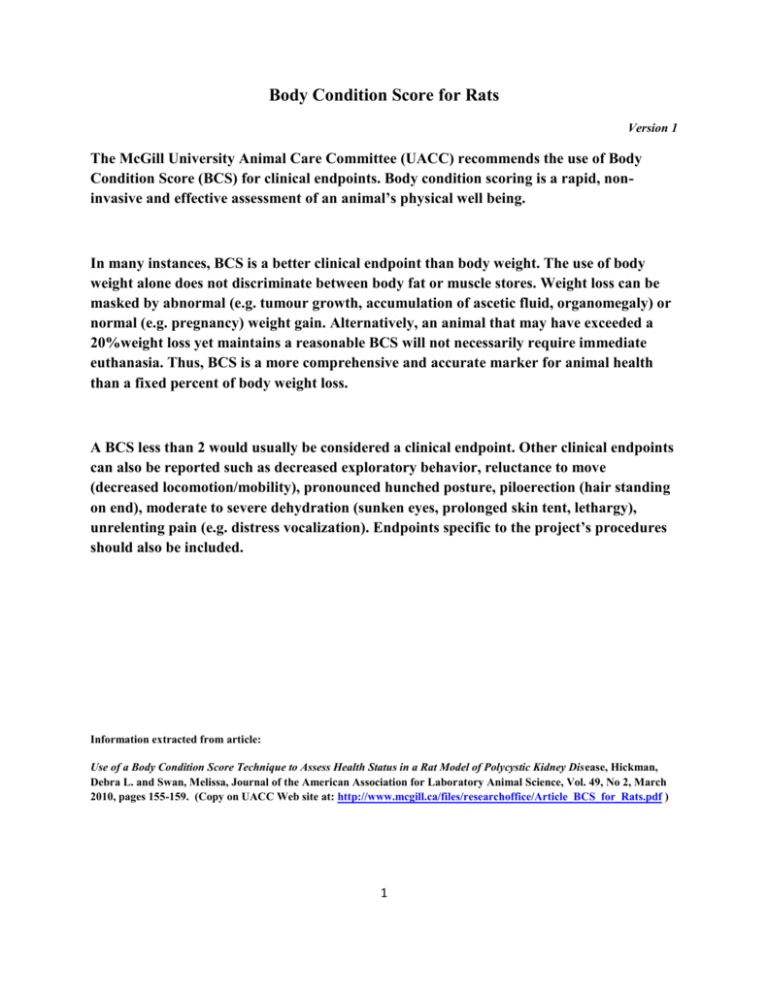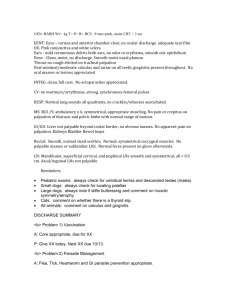Body Condition Score Outline For Rats
advertisement

Body Condition Score for Rats Version 1 The McGill University Animal Care Committee (UACC) recommends the use of Body Condition Score (BCS) for clinical endpoints. Body condition scoring is a rapid, noninvasive and effective assessment of an animal’s physical well being. In many instances, BCS is a better clinical endpoint than body weight. The use of body weight alone does not discriminate between body fat or muscle stores. Weight loss can be masked by abnormal (e.g. tumour growth, accumulation of ascetic fluid, organomegaly) or normal (e.g. pregnancy) weight gain. Alternatively, an animal that may have exceeded a 20%weight loss yet maintains a reasonable BCS will not necessarily require immediate euthanasia. Thus, BCS is a more comprehensive and accurate marker for animal health than a fixed percent of body weight loss. A BCS less than 2 would usually be considered a clinical endpoint. Other clinical endpoints can also be reported such as decreased exploratory behavior, reluctance to move (decreased locomotion/mobility), pronounced hunched posture, piloerection (hair standing on end), moderate to severe dehydration (sunken eyes, prolonged skin tent, lethargy), unrelenting pain (e.g. distress vocalization). Endpoints specific to the project’s procedures should also be included. Information extracted from article: Use of a Body Condition Score Technique to Assess Health Status in a Rat Model of Polycystic Kidney Disease, Hickman, Debra L. and Swan, Melissa, Journal of the American Association for Laboratory Animal Science, Vol. 49, No 2, March 2010, pages 155-159. (Copy on UACC Web site at: http://www.mcgill.ca/files/researchoffice/Article_BCS_for_Rats.pdf ) 1 BCS 1 - Rat is emaciated Segmentation of vertebral column prominent if not visible. Little or no flesh cover over dorsal pelvis. Pins prominent if not visible. Segmentation of caudal vertebrae prominent. BCS 2 - Rat is under conditioned Segmentation of vertebral column prominent. Thin flesh cover over dorsal pelvis, little subcutaneous fat. Pins easily palpable. Thin flesh cover over caudal vertebrae, segmentation palpable with slight pressure. BCS 3 - Rat is well-conditioned Segmentation of vertebral column easily palpable. Moderate subcutaneous fat store over pelvis. Pins easily palpable with slight pressure. Moderate fat store around tail base, caudal vertebrae may be palpable but not segmented. BCS 4 - Rat is overconditioned Segmentation of vertebral column palpable with slight pressure. Thick subcutaneous fat store over dorsal pelvis. Pins of pelvis palpable with firm pressure. Thick fat store over tail base, caudal vertebrae not palpable. BCS 5 - Rat is obese Segmentation of vertebral column palpable with firm pressure; may be a continuous column. Thick subcutaneous fat store over dorsal pelvis. Pins of pelvis not palpable with firm pressure. Thick fat store over tail base, caudal vertebrae not palpable. 2






